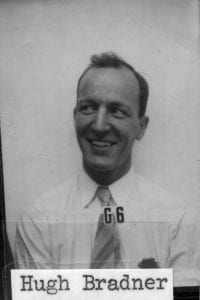“I was raised to love my country. I had no compunction about bombing an enemy if it meant ending the war.”

BIRTH AND EARLY YEARS
American physicist Hugh “Brad” Bradner was born on November 5th, 1915. After spending most of his childhood in Findley, Ohio, Bradner eventually moved out to attend college, graduating from Miami University in Oxford, Ohio. He later earned his Ph. D in physics from the California Institute of Technology in 1941.
Starting in 1941, Bradner worked for two years at the United States Naval Ordinance Laboratory in Washington, D.C. during World War II, where he was tasked with designing and building magnetic anti-shipping mines. Eventually Bradner became bored, even infuriated at the slow pace of activity in the workplace, and requested a transfer.
As per his request, Bradner was transferred to Chicago in February, 1943, where he would start his work on the Manhattan Project.
WORKING on THE MANHATTAN PROJECT
Shortly after transferring to Chicago, Bradner was recruited by Julius Robert Oppenheimer to work on the Manhattan Project at the Los Alamos Laboratories. During his time at the laboratories, Bradner worked in conjunction with other scientists to develop high explosives and exploding bridge-wire detonators for use in atomic bombs, as well as searching for a way to trigger a nuclear chain reaction.
Apart from developing on mechanisms for atomic bombs, Bradner was also involved with designing the new town to be situated around the Los Alamos laboratories, searching Chicago phone directories for businesses which could be put in the town (Bradner apparently forgot to put a bank in the town, so people weren’t able to conveniently manage their finances).
Bradner was given informal permission to record video around Los Alamos during his time working on the Manhattan Project. Though he mostly recorded non-work related activities such as hiking and skiing, Bradner occasionally recorded clips of scientific experiments, one clip being of the RaLa “radioactive lanthanum” Experiment which tested the design of a plutonium-based weapon. Bradner also recorded scientists departing for Trinity, the codename given for the first detonation of a nuclear weapon, in which he himself had also attended.
According to Bradner’s family, Bradner had said on the subject of the usage of nuclear weapons against Japan in 1945, “I was raised to love my country. I had no compunction about bombing an enemy if it meant ending the war.”
POST MANHATTAN PROJECT
After World War II and his time at the Los Alamos Laboratories, Bradner returned to California to become a physics professor at the University of California, Berkeley, as well engaging in research on high-energy physics at the Lawrence Berkeley National Laboratory.
During his off-time, Bradner was pursuing his hobby of diving. This love of diving, along with his intellect and physics knowledge, is what led Bradner to eventually create a neoprene-suit, which could trap water in between the neoprene layer and the body, warming the trapped water and thereby keeping the body warm. Bradner was eventually nicknamed and known as, “father of the wetsuit”.
Bradner continued his research on nuclear physics at the European Organization for Nuclear Research (CERN) in 1951, and on Operation Greenhouse (a nuclear test series) also in 1951. Eventually Bradner made the jump from nuclear physics to geophysics in 1961, joining the Scripps Institute of Geophysics and Planetary Physics as a geophysicist and becoming a professor of geophysics in 1963.
RETIREMENT and the next great adventure
Bradner eventually retired from Scripps in 1980, but continued research on oceanographic research, as well as doing work on the DUMAND deep ocean neutrino astronomy project, a project for a proposed underwater neutrino telescope to be built in the Pacific Ocean.
On May 5th, Bradner passed away at the age of 92 in San Diego, California, due to complications of pneumonia. This marked the death of a great American physicist who contributed to many great things to American society.
SOURCES
- “Hugh Bradner.” Atomic Heritage Foundation. N.p., 05 Nov. 1915. Web. 07 Jan. 2018.
- Rainey, C. “Wet Suit Pursuit: Hugh Bradner’s Development of the First Wet Suit”. UC San Diego, Scripps Institution of Oceanography Archives, Scripps Institution of Oceanography.
- “The Birth of High-Energy Neutrino Astronomy: A Personal History of the DUMAND Project”. University of Hawaii.
- “Hugh Bradner.” Wikipedia. Wikimedia Foundation, 05 Jan. 2018. Web. 07 Jan. 2018.
- “Trinity (nuclear Test).” Wikipedia. Wikimedia Foundation, 05 Jan. 2018. Web. 07 Jan. 2018.

